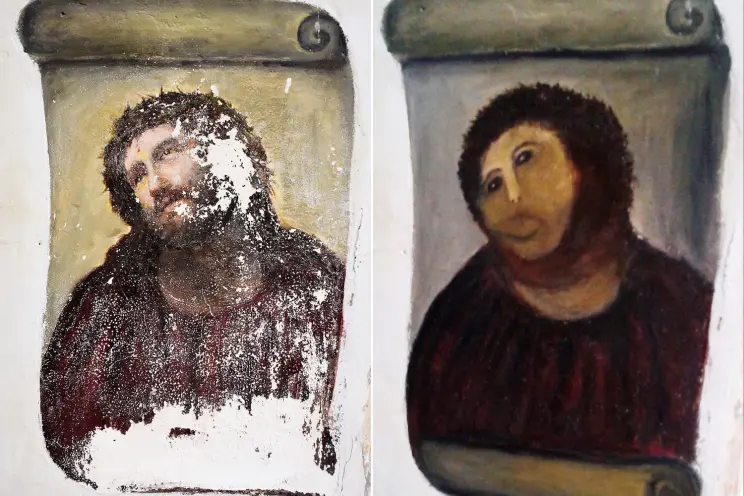Ecce Homo

I find it interesting to observe people. I am particularly intrigued by the differences in what folks place value on and also what people consider ruined. I know people who would not wear a shirt with a stain or a small hole while other people would simply consider such marks as character. I see people put enormous amounts of time and energy into keeping their car clean while others clearly value and spend their time on something else.
One story of something being ruined that ended up making international news was the story and pictures of Celia Gimenez's renovation efforts of the "Ecce Homo" (Behold the Man) image on the wall of the Iglesia del Santuario de Misericodia in Borja, a small town in the province of Zaragoza in north-eastern Spain. This 20th century fresco had been badly damaged over time and had chipped off nearly a quarter of the artwork. Eighty year old Celia attempted to retouch the fresco and the result became an international embarrassment. The center for Borja Studies announced that the painting had been ruined and released the shocking picture. The image began appearing everywhere across the internet and has inspired many humorous memes.
While it is an unfortunate fate of an amazing and historic work of art there is also something in this story and image that I find familiar and even beautiful. Her attempt to recreate this image resulted in a horrible dis-figuration of the original. I cannot help but think to myself how often we do just this with the image of Jesus. We try, often with the best of intentions, to recreate his image in this world only to produce something hideous. Our attempts often fall short of even resembling a healthy human let alone the man who demonstrated to all what man was created to be. We try to fill in the blanks of the vague and somewhat incomplete vision we have of that "image of the invisible God" only to find that we have distorted even what little understanding and clarity we did have. This image is beautiful to me because of how truly it reflects all of our defacing of Jesus. To me, it stands as an icon of our shortcomings and the result of our attempts at religious devotion.
Her retouching of this painting did not make Jesus’ image more visible but it did remind me that his image is not captured in paintings as much as it is in His ability to love and forgive those of us who make such mistakes. Jesus loves Celia as well as the rest of us who fail so miserably at reproducing his image in this world. This painting is beautiful to me because I believe it is to God as well. I have a friend who always hangs terrible drawings on his fridge because his child scribbled them. They are horrible scribbles and resemble nothing, but he is proud to display this evidence of his child's effort and development. In a similar was I can imagine this "Ecce Homo" hanging on the fridge in the Kingdom of God.
After some time, another news story came out about the woman, the north-eastern Spanish church, and the town that it is in. The Mayor of this small town of only about 5,000 people has come out and said that “We should be thanking her” because of all of the attention and tourism this ruined fresco has produced there. The ruining of this painting has been an unexpected blessing to the church and town. Ruins are intriguing. And sometimes invaluable. We waste so much because we do not properly value it. We waste our pain, our fears, our suffering, and our doubts because we do not see their value.
Any one of us might have an apple with our lunch, finish it, and throw the core into a trash can or waste basket. We are finished with the apple, see no use for its core and pitch it. That apple core finds itself in an inorganic bag full of inorganic waste on its way to the landfill. In my city that bag would most likely be incinerated at a waste to energy plant where it is turned into ash. Another person might see that very same apple core and recognize the value within it. That apple core is organic and full of rich nutrients that would be lost if burned up. Those nutrients could provide fertilization to the soil in our communities if it is allowed to decompose in a compost pile. That ‘waste’ which we might easily throw away could produce life and food if valued enough to get it into the yard. Waste is only waste if we waste it. Waste is, like beauty, in the eye of the beholder.
